7B Unit 8 Pets Grammar课件25张
文档属性
| 名称 | 7B Unit 8 Pets Grammar课件25张 | 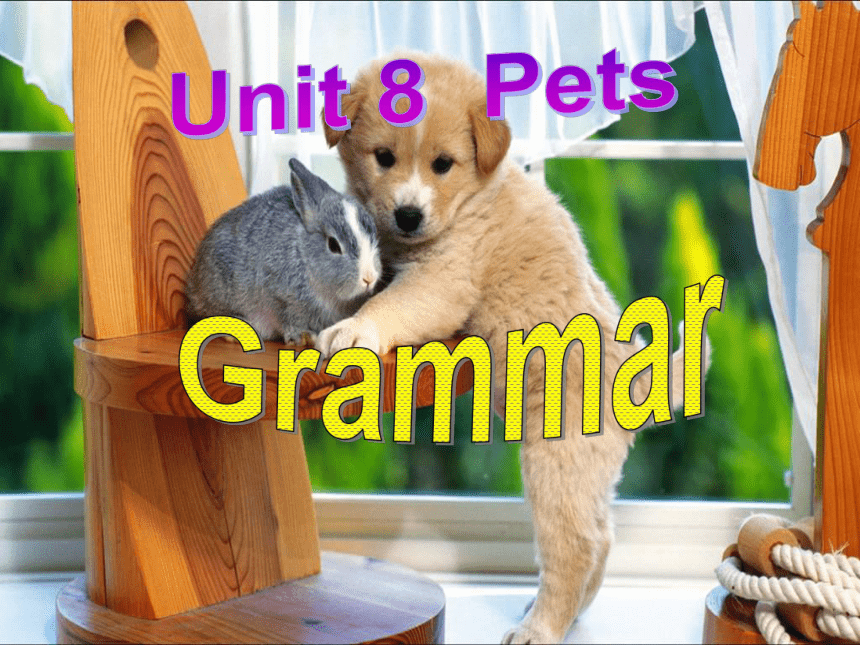 | |
| 格式 | zip | ||
| 文件大小 | 1.1MB | ||
| 资源类型 | 教案 | ||
| 版本资源 | 牛津译林版 | ||
| 科目 | 英语 | ||
| 更新时间 | 2021-04-12 07:46:36 | ||
图片预览


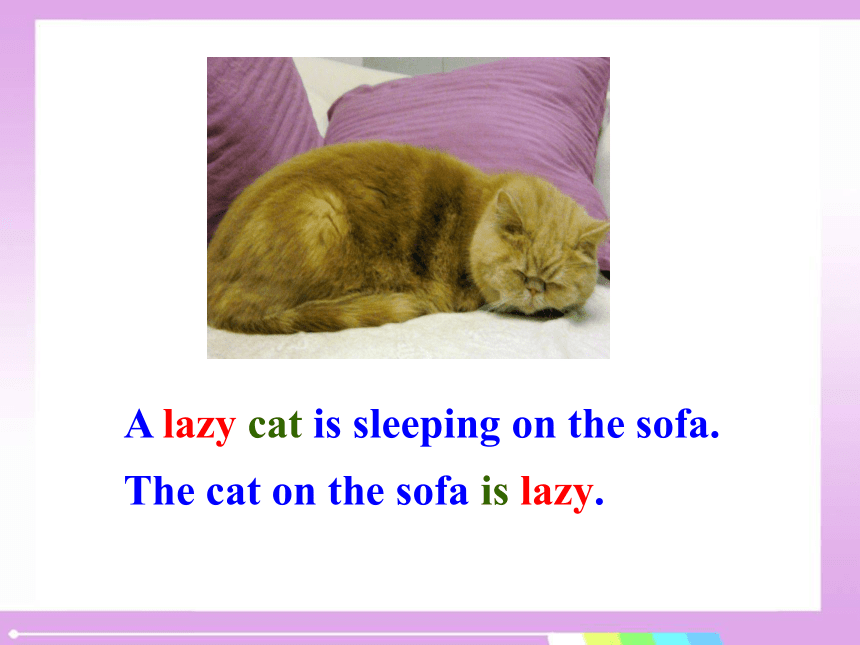
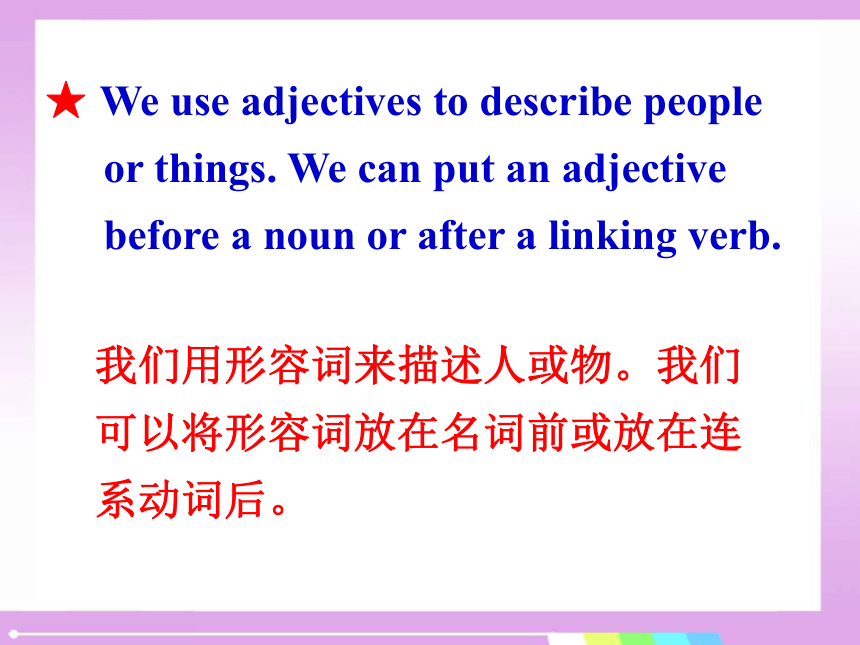
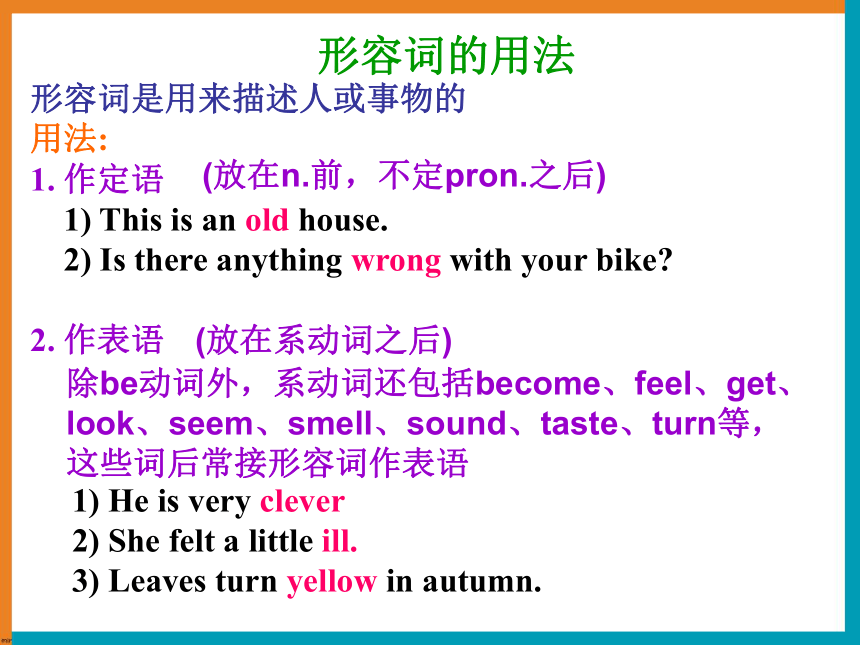
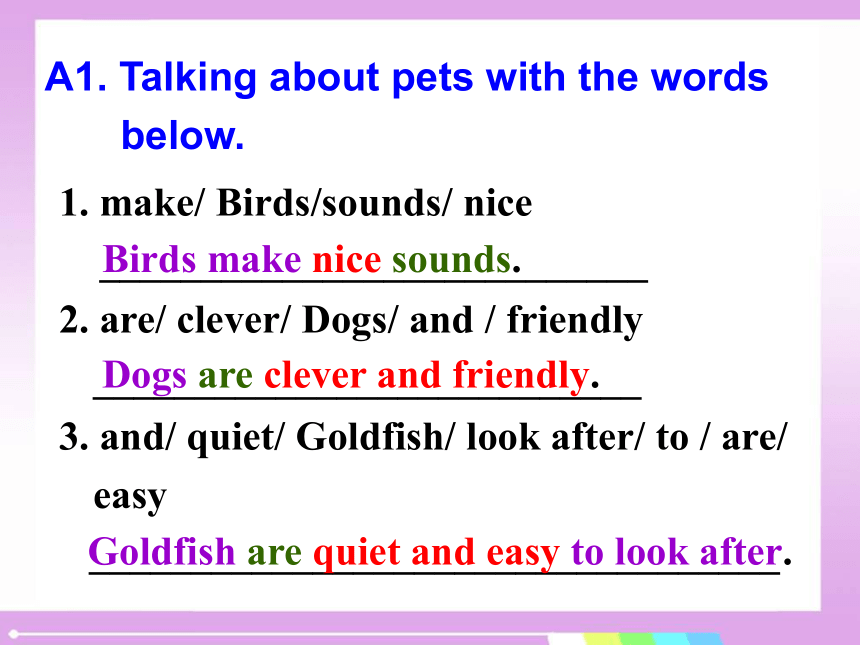

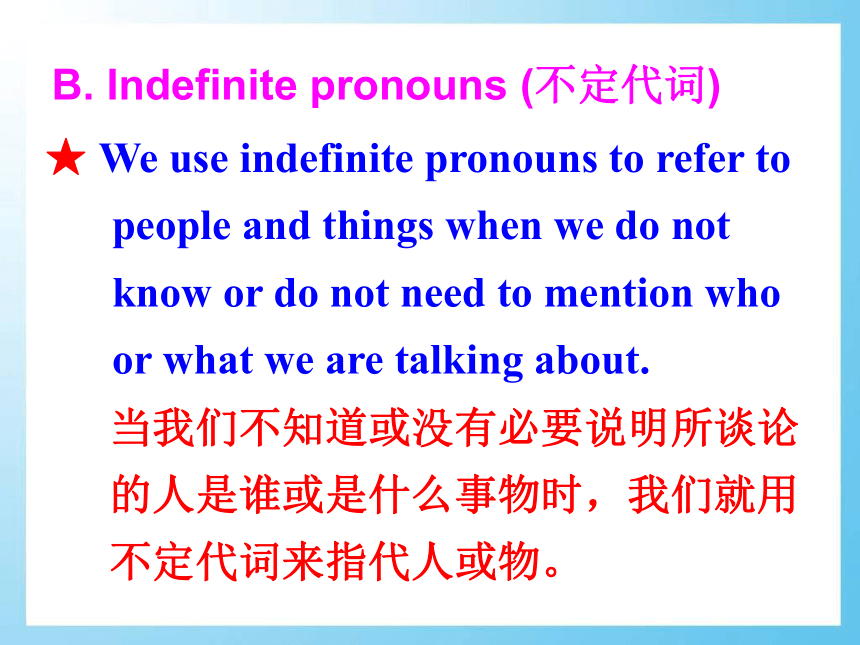

文档简介
(共25张PPT)
A.
Using
adjectives
(使用形容词)
Rabbits
have
long
ears.
Rabbits’
ears
are
long.
A
lazy
cat
is
sleeping
on
the
sofa.
The
cat
on
the
sofa
is
lazy.
我们用形容词来描述人或物。我们可以将形容词放在名词前或放在连系动词后。
★
We
use
adjectives
to
describe
people
or
things.
We
can
put
an
adjective
before
a
noun
or
after
a
linking
verb.
形容词的用法
形容词是用来描述人或事物的
用法:
1.
作定语
1)
This
is
an
old
house.
2)
Is
there
anything
wrong
with
your
bike?
2.
作表语
1)
He
is
very
clever
2)
She
felt
a
little
ill.
3)
Leaves
turn
yellow
in
autumn.
除be动词外,系动词还包括become、feel、get、
look、seem、smell、sound、taste、turn等,
这些词后常接形容词作表语
(放在n.前,不定pron.之后)
(放在系动词之后)
1.
make/
Birds/sounds/
nice
___________________________
2.
are/
clever/
Dogs/
and
/
friendly
___________________________
3.
and/
quiet/
Goldfish/
look
after/
to
/
are/
easy
__________________________________
Birds
make
nice
sounds.
Dogs
are
clever
and
friendly.
Goldfish
are
quiet
and
easy
to
look
after.
A1.
Talking
about
pets
with
the
words
below.
I
have
a
_____
cat.
She
likes
to
run
after
balls.
When
she
gets
_____,
she
sleeps
anywhere.
She
miaows
when
she
is
______.
My
parrot
is
a
______
friend
of
mine.
He
is
very
_____,
and
he
can
repeat
my
words.
He
says
“Hello!”
when
I
come
back
home.
He
is
_____
all
the
time.
black
black
clever
happy
hungry
special
tired
tired
hungry
special
clever
happy
A2.
Help
Daniel
complete
his
article.
当我们不知道或没有必要说明所谈论的人是谁或是什么事物时,我们就用不定代词来指代人或物。
B.
Indefinite
pronouns
(不定代词)
★
We
use
indefinite
pronouns
to
refer
to
people
and
things
when
we
do
not
know
or
do
not
need
to
mention
who
or
what
we
are
talking
about.
不定代词
代替或修饰不特指的人或事物的代词叫不定代词。
some,
any,
every,
no都能和one,
body,
thing一起构成代词,这些代词叫复合不定代词。它们基本含义为:
somebody、someone
某人
anybody、anyone
某人/任何人
everybody、everyone
每个人
nobody、no
one
没有人
指人:
指物
something
某物
anything
某物/任何物
everything
每件事,一切
nothing
没事
I
saw
___________________
(有人)
in
the
house.
How
to
use
indefinite
pronouns?
somebody
(=someone)
There
is
____________
(某个东西)under
the
bed.
something
We
use
somebody,
someone
and
something
in
positive
sentences.
When
we
are
offering
something
or
when
we
expect
the
answer
to
be
‘yes’,
we
can
use
something,
somebody/
someone
in
questions.
Would
you
like
something
to
eat?
Is
someone
there?
I
did
not
see
_________________(有人)in
the
house.
anybody
(=anyone)
There
is
not
________(某个东西)under
the
bed.
anything
We
use
anybody,
anyone
and
anything
in
negative
sentences
or
in
questions.
Do
you
feed
your
goldfish
________(某物)else?
anything
There
is
________________(没人)in
the
living
room.
nobody
(=
no
one)
I
saw
_______(没东西)in
the
fridge.
nothing
We
use
nobody,
no
one
and
nothing
to
refer
to
‘not
anyone’
and
‘not
anything’.
There
isn’t
anybody
in
the
room.
=
There
is
_____________
in
the
room.
I
did
not
hear
anything.
=
I
heard
_______.
nobody/no
one
nothing
Is
_________________
(每个人)
here
today?
__________
(每样东西)
is
ready.
everybody/everyone
Everything
We
use
everybody,
everyone
and
everything
to
refer
to
‘all
people’
and
‘all
things’.
Mr
Hu
is
asking
the
students
about
their
pets.
Complete
their
conversation
with
the
correct
indefinite
pronouns.
Mr
Wu:
Millie,
I
know
you
have
a
dog.
What
do
you
feed
him?
Millie:
We
usually
give
him
dog
food.
Mr
Wu:
Do
you
feed
him
________
else?
Millie:
Yes.
Sometimes
we
give
him
some
meat.
He
likes
it.
Mr
Wu:
I
see.
Does
________________
have
a
cat?
Amy:
Yes,
I
have
a
cat.
She’s
nice
to
_____________________.
Mr
Wu:
Good.
I
know
_________________
has
goldfish,
right?
anything
anyone
(anybody)
everybody
(everyone)
somebody
(someone)
Peter:
Yes,
I
do.
Goldfish
are
easy
to
look
after.
Mr
Wu:
That’s
true.
Does
______________
have
a
snake?
Kitty:
No.
_______________
wants
a
snake,
I
think.
Daniel:
I
don’t
agree.
There’s
_______
wrong
with
keeping
a
snake
if
you
like
it.
nothing
anyone
(anybody)
Nobody
(no
one)
形容词
定义
用来表示人或事物特征、性质的词。
用法
1.
放在名词前(作定语)。
2.
放在连系动词后(作表语)。
举例
It’s
a
nice
gift.
He
is
very
friendly.
You
look
tired
today.
一、使用形容词
指人
somebody/someone
anybody/
anyone
nobody/
no
one
everybody/
everyone
指物
something
anything
nothing
everything
用法
用肯定句以及表示期待对方给予肯定回答的问句中。
用于否定句、疑问句以及表示强调的肯定句中。
在句中用来表示否定,相当于not
any-
表示所有的人或物。
注意
1.
所有不定代作主语时谓语动词用单数形式
2.
形容词修饰不定代词时,形容词要后置。
二、不定代词:用来指不定数量或范围的人或物。
1.
Someone
_____
(want)
to
see
you
at
the
school
gate.
2.
There
__
(be)
nothing
wrong
with
the
car.
3.
Mother
will
buy
me
_________
____
(好吃的东西)
this
afternoon.
4.
How
is
__________
(一切)
going?
5.
She
eats
nothing
in
the
morning.
=
She
______
___
________
in
the
morning.
wants
is
something
nice
everything
doesn’t
eat
anything
Useful
phrases
1.
make
nice
sounds
2.
be
easy
to
look
after
3.
get
tired
4.
sleep
anywhere
5.
a
special
friend
of
mine
6.
repeat
my
words
7.
come
back
home
8.
all
the
time
9.
There
is
nobody/no
one
in
the
house.
10.
Is
everybody/everyone
here
today?
11.
Everything
is
ready.
12.
anything
else
发出美丽的声音
容易照看
变累
回到家
一直,总是
今天大家都到了吗?
房子里没人
一切准备好了
任何别的东西
重复我的话
我的一位特殊的朋友
睡在任何地方
我不同意
养蛇是没有什么问题的
13.
I
don’t
agree.
14.
There
is
nothing
wrong
with
keeping
a
snake.
1.
There
is
not
________
(something)
in
the
box.
2.
I’m
glad
to
see
that
_________
(somebody)
is
here
today.
3.
_______
(anything)
is
difficult
if
you
put
your
heart
into
it.
4.
People
in
the
shop
are
_______
(friend)
to
us.
5.
My
dog
is
the
_______
(clever)
animal
of
all.
一、用所给词的适当形式填空。
anything
everybody
Nothing
friendly
cleverest
1.
Hobo叫Eddie不要对他不礼貌。
Hobo
asks
Eddie
not
to
_______
to
him.
2.
我的狗是我的一位特殊朋友。
My
dog
is
a
___________________.
3.
金鱼很容易照看。
Goldfish
are
________________.
4.
如果你喜欢,养蛇也没什么不对。
There’s
_______
wrong
with
_______
_______
if
you
like.
special
friend
of
mine
be
rude
easy
to
look
after
a
snake
nothing
keeping
二、翻译
Remember
the
use
of
adjectives
and
the
indefinite
pronouns.
Preview
the
new
words
in
the
next
lesson.
Homework
A.
Using
adjectives
(使用形容词)
Rabbits
have
long
ears.
Rabbits’
ears
are
long.
A
lazy
cat
is
sleeping
on
the
sofa.
The
cat
on
the
sofa
is
lazy.
我们用形容词来描述人或物。我们可以将形容词放在名词前或放在连系动词后。
★
We
use
adjectives
to
describe
people
or
things.
We
can
put
an
adjective
before
a
noun
or
after
a
linking
verb.
形容词的用法
形容词是用来描述人或事物的
用法:
1.
作定语
1)
This
is
an
old
house.
2)
Is
there
anything
wrong
with
your
bike?
2.
作表语
1)
He
is
very
clever
2)
She
felt
a
little
ill.
3)
Leaves
turn
yellow
in
autumn.
除be动词外,系动词还包括become、feel、get、
look、seem、smell、sound、taste、turn等,
这些词后常接形容词作表语
(放在n.前,不定pron.之后)
(放在系动词之后)
1.
make/
Birds/sounds/
nice
___________________________
2.
are/
clever/
Dogs/
and
/
friendly
___________________________
3.
and/
quiet/
Goldfish/
look
after/
to
/
are/
easy
__________________________________
Birds
make
nice
sounds.
Dogs
are
clever
and
friendly.
Goldfish
are
quiet
and
easy
to
look
after.
A1.
Talking
about
pets
with
the
words
below.
I
have
a
_____
cat.
She
likes
to
run
after
balls.
When
she
gets
_____,
she
sleeps
anywhere.
She
miaows
when
she
is
______.
My
parrot
is
a
______
friend
of
mine.
He
is
very
_____,
and
he
can
repeat
my
words.
He
says
“Hello!”
when
I
come
back
home.
He
is
_____
all
the
time.
black
black
clever
happy
hungry
special
tired
tired
hungry
special
clever
happy
A2.
Help
Daniel
complete
his
article.
当我们不知道或没有必要说明所谈论的人是谁或是什么事物时,我们就用不定代词来指代人或物。
B.
Indefinite
pronouns
(不定代词)
★
We
use
indefinite
pronouns
to
refer
to
people
and
things
when
we
do
not
know
or
do
not
need
to
mention
who
or
what
we
are
talking
about.
不定代词
代替或修饰不特指的人或事物的代词叫不定代词。
some,
any,
every,
no都能和one,
body,
thing一起构成代词,这些代词叫复合不定代词。它们基本含义为:
somebody、someone
某人
anybody、anyone
某人/任何人
everybody、everyone
每个人
nobody、no
one
没有人
指人:
指物
something
某物
anything
某物/任何物
everything
每件事,一切
nothing
没事
I
saw
___________________
(有人)
in
the
house.
How
to
use
indefinite
pronouns?
somebody
(=someone)
There
is
____________
(某个东西)under
the
bed.
something
We
use
somebody,
someone
and
something
in
positive
sentences.
When
we
are
offering
something
or
when
we
expect
the
answer
to
be
‘yes’,
we
can
use
something,
somebody/
someone
in
questions.
Would
you
like
something
to
eat?
Is
someone
there?
I
did
not
see
_________________(有人)in
the
house.
anybody
(=anyone)
There
is
not
________(某个东西)under
the
bed.
anything
We
use
anybody,
anyone
and
anything
in
negative
sentences
or
in
questions.
Do
you
feed
your
goldfish
________(某物)else?
anything
There
is
________________(没人)in
the
living
room.
nobody
(=
no
one)
I
saw
_______(没东西)in
the
fridge.
nothing
We
use
nobody,
no
one
and
nothing
to
refer
to
‘not
anyone’
and
‘not
anything’.
There
isn’t
anybody
in
the
room.
=
There
is
_____________
in
the
room.
I
did
not
hear
anything.
=
I
heard
_______.
nobody/no
one
nothing
Is
_________________
(每个人)
here
today?
__________
(每样东西)
is
ready.
everybody/everyone
Everything
We
use
everybody,
everyone
and
everything
to
refer
to
‘all
people’
and
‘all
things’.
Mr
Hu
is
asking
the
students
about
their
pets.
Complete
their
conversation
with
the
correct
indefinite
pronouns.
Mr
Wu:
Millie,
I
know
you
have
a
dog.
What
do
you
feed
him?
Millie:
We
usually
give
him
dog
food.
Mr
Wu:
Do
you
feed
him
________
else?
Millie:
Yes.
Sometimes
we
give
him
some
meat.
He
likes
it.
Mr
Wu:
I
see.
Does
________________
have
a
cat?
Amy:
Yes,
I
have
a
cat.
She’s
nice
to
_____________________.
Mr
Wu:
Good.
I
know
_________________
has
goldfish,
right?
anything
anyone
(anybody)
everybody
(everyone)
somebody
(someone)
Peter:
Yes,
I
do.
Goldfish
are
easy
to
look
after.
Mr
Wu:
That’s
true.
Does
______________
have
a
snake?
Kitty:
No.
_______________
wants
a
snake,
I
think.
Daniel:
I
don’t
agree.
There’s
_______
wrong
with
keeping
a
snake
if
you
like
it.
nothing
anyone
(anybody)
Nobody
(no
one)
形容词
定义
用来表示人或事物特征、性质的词。
用法
1.
放在名词前(作定语)。
2.
放在连系动词后(作表语)。
举例
It’s
a
nice
gift.
He
is
very
friendly.
You
look
tired
today.
一、使用形容词
指人
somebody/someone
anybody/
anyone
nobody/
no
one
everybody/
everyone
指物
something
anything
nothing
everything
用法
用肯定句以及表示期待对方给予肯定回答的问句中。
用于否定句、疑问句以及表示强调的肯定句中。
在句中用来表示否定,相当于not
any-
表示所有的人或物。
注意
1.
所有不定代作主语时谓语动词用单数形式
2.
形容词修饰不定代词时,形容词要后置。
二、不定代词:用来指不定数量或范围的人或物。
1.
Someone
_____
(want)
to
see
you
at
the
school
gate.
2.
There
__
(be)
nothing
wrong
with
the
car.
3.
Mother
will
buy
me
_________
____
(好吃的东西)
this
afternoon.
4.
How
is
__________
(一切)
going?
5.
She
eats
nothing
in
the
morning.
=
She
______
___
________
in
the
morning.
wants
is
something
nice
everything
doesn’t
eat
anything
Useful
phrases
1.
make
nice
sounds
2.
be
easy
to
look
after
3.
get
tired
4.
sleep
anywhere
5.
a
special
friend
of
mine
6.
repeat
my
words
7.
come
back
home
8.
all
the
time
9.
There
is
nobody/no
one
in
the
house.
10.
Is
everybody/everyone
here
today?
11.
Everything
is
ready.
12.
anything
else
发出美丽的声音
容易照看
变累
回到家
一直,总是
今天大家都到了吗?
房子里没人
一切准备好了
任何别的东西
重复我的话
我的一位特殊的朋友
睡在任何地方
我不同意
养蛇是没有什么问题的
13.
I
don’t
agree.
14.
There
is
nothing
wrong
with
keeping
a
snake.
1.
There
is
not
________
(something)
in
the
box.
2.
I’m
glad
to
see
that
_________
(somebody)
is
here
today.
3.
_______
(anything)
is
difficult
if
you
put
your
heart
into
it.
4.
People
in
the
shop
are
_______
(friend)
to
us.
5.
My
dog
is
the
_______
(clever)
animal
of
all.
一、用所给词的适当形式填空。
anything
everybody
Nothing
friendly
cleverest
1.
Hobo叫Eddie不要对他不礼貌。
Hobo
asks
Eddie
not
to
_______
to
him.
2.
我的狗是我的一位特殊朋友。
My
dog
is
a
___________________.
3.
金鱼很容易照看。
Goldfish
are
________________.
4.
如果你喜欢,养蛇也没什么不对。
There’s
_______
wrong
with
_______
_______
if
you
like.
special
friend
of
mine
be
rude
easy
to
look
after
a
snake
nothing
keeping
二、翻译
Remember
the
use
of
adjectives
and
the
indefinite
pronouns.
Preview
the
new
words
in
the
next
lesson.
Homework
